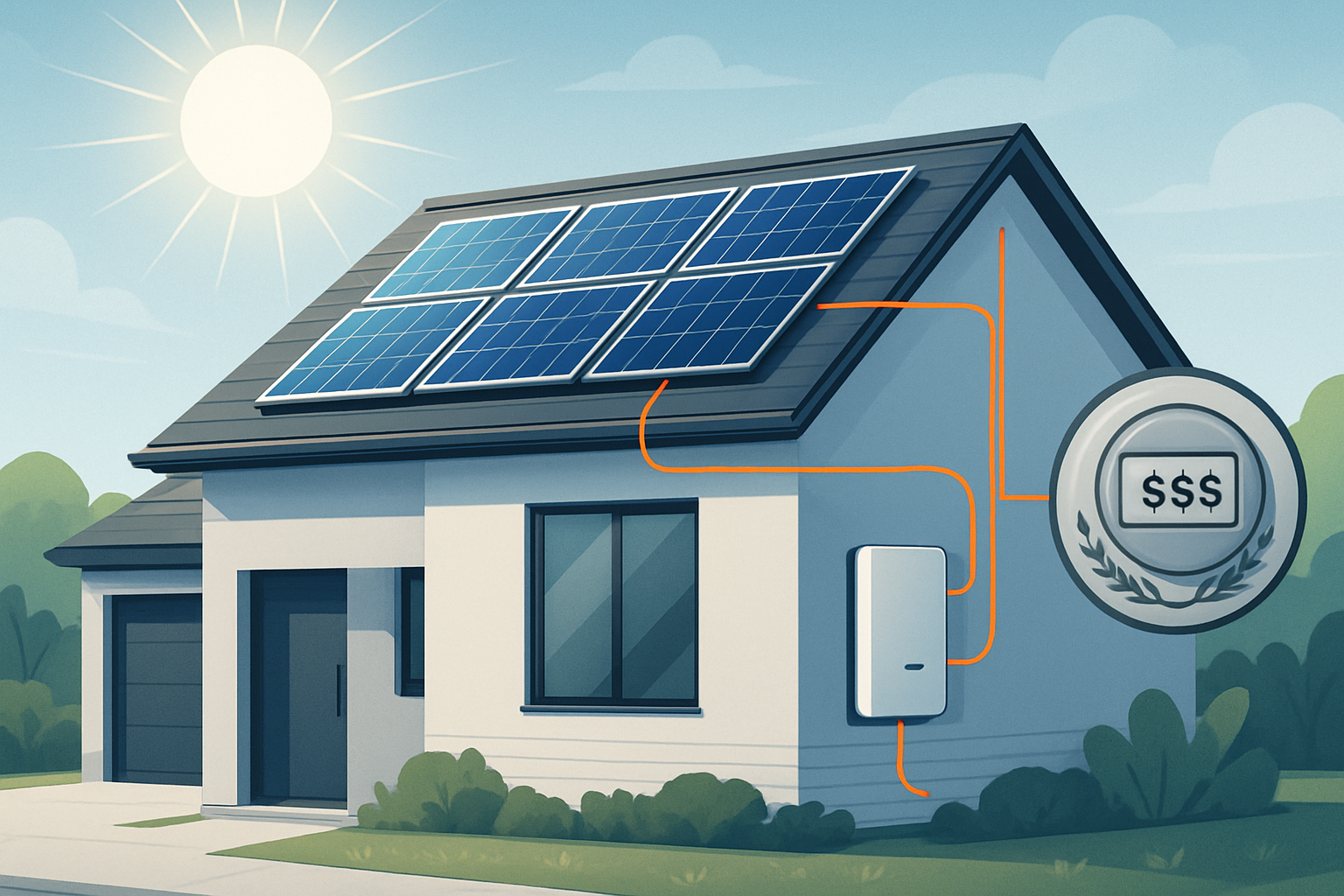Considering solar energy for your home or business is a significant decision. You want to understand the financial benefits, especially how long it takes to recover your initial investment. This period is often called the payback period. Many online tools, or solar calculators, promise to provide these estimates. We will examine these tools, explore the factors that influence solar investment returns, and discuss how you can achieve true energy independence.
The Promise of Solar Calculators
Solar calculators offer a quick way to gauge the potential financial benefits of installing a solar energy system. You input details like your location, average electricity bill, and roof characteristics. The calculator then provides estimates for system size, installation costs, potential electricity bill savings, and the projected payback period.
What Solar Calculators Aim to Do
These tools are designed to simplify a complex calculation. They typically consider local solar irradiance data, average electricity rates, and assumed system costs. The goal is to give you a preliminary understanding of your solar potential and the financial viability of a solar installation. They can be a helpful starting point for your research.
Why Accurate Prediction Matters
An accurate prediction of your solar payback is crucial. It helps you make informed decisions about your energy future. A realistic estimate allows for proper financial planning and sets clear expectations for your investment. Misleading projections can lead to disappointment or missed opportunities for greater savings.

Real-World Variables Affecting Solar Payback
While solar calculators provide a baseline, many real-world variables significantly influence your actual payback period. Understanding these factors helps you evaluate the reliability of any calculator's output.
System Size and Initial Investment
The total cost of your solar system is a primary factor. This cost depends on the system's size, measured in kilowatts (kW), and the type of equipment you choose. The average cost of a residential solar installation in 2025 is approximately $3.00 per watt before incentives. However, costs can vary based on location, installer, and specific equipment. Consider that solar panel costs have decreased significantly, becoming about 60% cheaper than in 2010.
Energy Consumption and Production
Your household's energy consumption patterns directly impact your savings. A system sized to meet your specific energy needs will maximize your self-consumption and reduce reliance on grid electricity. Solar panel efficiency has also seen remarkable improvements. Current commercially available solar panels typically range from 19% to 22% in efficiency, a notable increase from the 15% average in 2010. This means more electricity generated from a smaller roof area.
Keep in mind that solar panels do experience a slight decrease in efficiency over time, known as degradation. The National Renewable Energy Laboratory (NREL) estimates this rate to be around 0.5% per year. This gradual degradation is factored into long-term performance warranties.
Incentives and Policies
Government incentives play a substantial role in reducing the net cost of a solar installation and shortening the payback period. For example, the U.S. federal solar Investment Tax Credit (ITC) allows you to claim a percentage of your system's cost as a tax credit. This credit was expanded to 30% for systems installed between 2022 and 2032. It also includes battery storage systems, making integrated solutions even more attractive.
Local and state incentives, such as rebates, performance-based incentives (PBIs), and net metering policies, also contribute significantly. Net metering allows you to send excess electricity generated by your panels back to the grid, often earning credits on your electricity bill. These policies vary widely by region, so checking local regulations is important.
Evaluating Solar Calculator Accuracy
While useful, generic solar calculators have limitations. Their accuracy relies heavily on the quality of their underlying data and the assumptions they make.
Data Inputs and Assumptions
Many online calculators use generalized data for electricity rates, solar irradiance, and system costs. Your actual electricity rates might differ, and they can fluctuate. For instance, U.S. residential electricity rates climbed 32% between 2014 and 2024. A calculator might not account for future rate increases or the specific nuances of your utility's billing structure. Similarly, the amount of sunlight your roof receives can vary based on shading from trees or nearby buildings, which generic tools may not fully capture.
Real-world Performance vs. Predictions
The true performance of a solar system can vary from initial predictions due to weather patterns, panel degradation, and even dust accumulation. A professional solar assessment provides a much more accurate forecast by considering these specific site conditions. It includes detailed shade analysis, precise energy consumption profiling, and a tailored system design. This personalized approach reduces the margin of error significantly.
Here is a comparison of typical calculator assumptions versus real-world considerations:
| Factor | Typical Calculator Assumption | Real-World Consideration |
|---|---|---|
| Electricity Rates | Fixed or simple percentage increase | Variable, influenced by fuel costs, demand, and utility regulations. The U.S. Energy Information Administration (EIA) projected a 1% rise in residential electricity prices for 2024. |
| Solar Irradiance | Regional average | Site-specific, considering shading, roof angle, and orientation. |
| System Cost | National or regional average per watt | Varies by installer, equipment brand, labor, and specific installation challenges. |
| System Degradation | Often not explicitly shown or generalized | Panels degrade approximately 0.5% per year, impacting long-term output. |
| Incentives | Federal ITC included, local may be generalized | Requires detailed understanding of all applicable federal, state, and local programs. |
Beyond Calculation: Optimizing Your Solar Investment
Achieving optimal payback involves more than just selecting a solar system. It means integrating a comprehensive energy solution that maximizes efficiency, reliability, and independence.
Integrated Energy Solutions
A truly optimized solar investment often extends beyond solar panels to include energy storage. By pairing solar panels with a robust home energy storage system, you can capture excess solar energy generated during the day and use it at night or during grid outages. This reduces your reliance on the grid even further and provides energy security.
Our experience in the solar industry has shown us the value of integrated systems. We focus on developing comprehensive solutions, including high-performance, safe, and reliable Lithium Iron Phosphate (LiFePO4) batteries. Our home energy storage systems seamlessly integrate these batteries with hybrid inverters and solar panels, providing a complete ecosystem for energy management. For properties without grid access, our off-grid solar solutions offer complete energy independence for homes, farms, and cabins. Our solar inverters convert the direct current (DC) electricity from your panels into alternating current (AC) for your home, ensuring efficient power delivery.
Long-term System Performance and Maintenance
The longevity and consistent performance of your solar energy system are vital for maximizing its financial returns. Regular monitoring and maintenance ensure your system operates at peak efficiency. Choosing high-quality components and an experienced installer contributes significantly to long-term reliability. The global installed solar PV capacity reached approximately 2.2 terawatts (TW) by the end of 2024, demonstrating the widespread adoption and continuous improvement in this technology.
Choosing the Right Solar Partner
Selecting a knowledgeable partner is as important as the technology itself. You need a partner who understands the intricacies of solar and energy storage, from technical details to financial implications.
Expertise in Integrated Systems
Look for a partner with extensive experience in the solar and energy storage sector. They should offer a range of products like advanced lithium batteries, integrated home energy storage systems, off-grid solar solutions, and efficient solar inverters. This breadth of expertise ensures they can design a solution tailored to your unique energy needs and goals.
Reliable Technology for Energy Independence
A reputable partner provides reliable and scalable energy solutions. Their commitment should be to help you achieve genuine energy independence through products designed for high performance and safety. Consider that new renewable power sources, including solar photovoltaics, consistently outcompete fossil fuels on cost. In 2024, 91% of new renewable energy projects were cheaper than the lowest-cost fossil fuel alternatives, with solar PV being 41% cheaper, averaging $0.043 per kilowatt-hour.
A Path to Informed Energy Decisions
Solar calculators offer a useful starting point for exploring solar energy's financial benefits. However, for a truly accurate and personalized assessment, consider working with professionals who can account for your specific circumstances and integrate comprehensive energy solutions. By combining quality technology with expert guidance, you can confidently move towards energy independence and realize the full potential of your solar investment.





Leave a comment
All comments are moderated before being published.
This site is protected by hCaptcha and the hCaptcha Privacy Policy and Terms of Service apply.